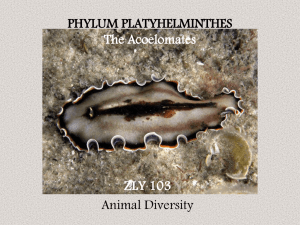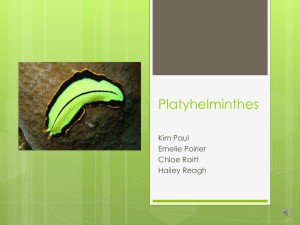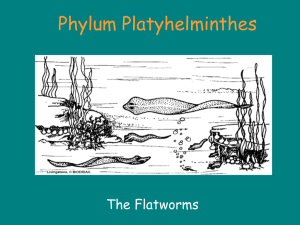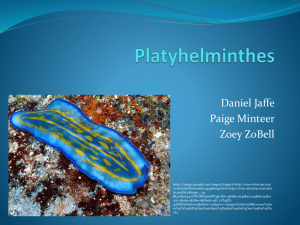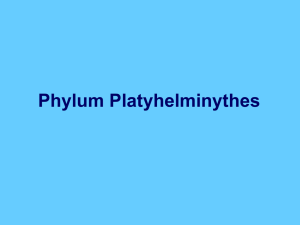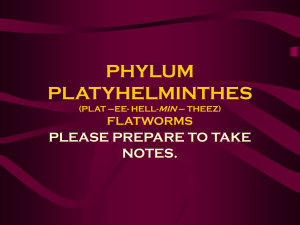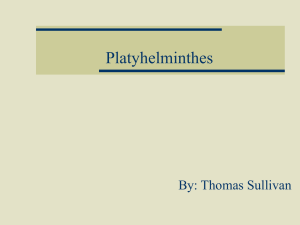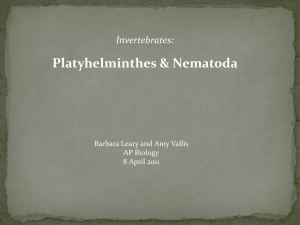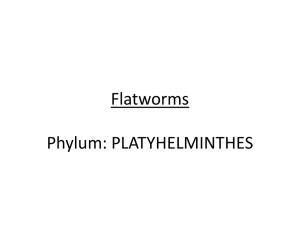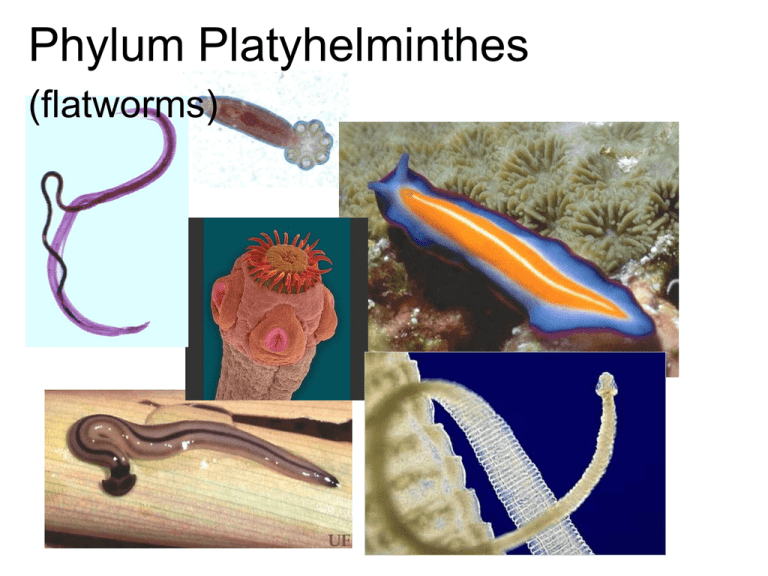
Phylum Platyhelminthes
(flatworms)
A phylogeny of
Animalia
Platyhelminthes
Bilateria
Phylum
Platyhelminthes
The Flatworms
Part 1: Free-living Flatworms
Emerging Patterns in Evolution
Bilateral symmetry
Dorsal
& ventral, anterior & posterior
Associated with locomotion on a solid surface
Evolution of a head end: cephalization
Possess
a head (leading end with sense
organs)
Internal fertilization
Bauplan
Dorsoventrally flattened
Lack
circulatory system for transport- must
rely on diffusion for gas exchange
Triploblastic
Embryo
has 3 cell layers
Ectoderm (cnidarians)
Endoderm (cnidarians)
AND NOW, introducing THE
MESODERM!
Acoelomate - Hey, where’s my cavity?
Phylum Platyhelminthes – tissue
organization
Triploblastic = 3 tissue
layers
Ectoderm (outer)
Endoderm (inner)
Mesoderm (between)
Muscles and Movement
Hydrostatic Skeleton
Bauplan
Nervous system
Anterior
brain
Paired ganglia and nerves
Paired
ventral nerve cords
Longitudinal
Lateral
Incomplete gut
No
anus
Food exits via mouth
Phylum Platyhelminthes - digestive
system
• Gastrovascular cavity
• Protrusible pharynx in some
taxa
• Digestion is both intracellular
and extracellular
Bauplan
Excretory system & osmoregulation
Diffusion
across body wall
Protonephridia
Specialized excretory organs
Probably mainly for water balance - produces
urine- a filtrate of extracellular fluid
May also help osmoregulate
Phylum Platyhelminthesexcretory system
“Protonephridial” system: blind-ending tubes with flame
cells & fenestrae at ends, connected with excretory
pores
Probably mainly for water balance
produces urine- a filtrate of extracellular fluid
Flatworms have extracellular fluid compartment
cells protected from external environment
Cnidaria
lack this- cells are in contact with water (in
freshwater cnidaria, each cell has prominent
contractile vacuoles)
Protonephridial osmoregulatory/excretory
system
“flame cell”
fenestrae
duct
Bauplan
Lack cuticle or other rigid skeletal support
Lack fluid-filled body cavity
Spermatozoa possess a pair of flagella that arise
from the paired centrioles
Epidermal cells are typically multiciliated.
Neoblasts---stem cells that give rise to the other
cell types in the body.
endoderm
Life History
Most are simultaneous hermaphrodites
Function
as male and female simultaneously
Transfer sperm and receive sperm simultaneously
Monoecious
Most
are not self-fertile
(A few exceptions)
Most
are oviparous (= produce shelled eggs
that are released and hatch outside the body).
Most can also reproduce asexually by
budding or transverse fission
Asexual reproduction by transverse fission
(budding)
Interesting in 2 ways:
1. Another flatworm class (cestoda) is
segmented - they grow by serial reproduction of
body parts
2. If you cut a turbellarian in half, it can regenerate
Regeneration involves undifferentiated cells in
mesoderm called neoblasts
Platyhelminthes- 4 classes
traditional
Class Cestoda
(tapeworms) all parasitic
Class Monogenea
(monogenetic trematodes, gill flukes) all parasitic
Class Trematoda
(digenetic trematodes, flukes) all parasitic
Class Turbellaria
(turbellarians) mostly free-living
Platyhelminthes
Inability of flatworms to synthesize fatty
acids and sterols may explain their need
for establishing symbiotic relationships
The parasitic classes of flatworms are
linked by a synapomorphythe tegument (see next slide)
Clade
Neodermata
Turbellaria
“Neodermata” The
parasitic flatworms)
(Tegument)
Classification
Phylum Platyhelminthes
Classes
Acoelomorpha:
Acoels (free-living) + Neodermata (parasites)
Turbellaria: free-living flatworms
Trematoda: flukes
All are parasites
Cestoda: tapeworms
All are parasites
Monogenea? (Maybe belong with cestoda)
Ectoparasites of fish
Turbellarians were traditionally classified
based on the form of the gastrovascular
cavity
Acoels are not Platyhelminthes???
rRNA analysis (see cladograms) shows that
Acoela is basal to other bilateral clades
Digestive syncytium instead of a gut
Netlike nervous system, lack brain
Kinked cilia
Acoel eggs cleave only once and the two resulting cells
immediately generate many small cells.
Link to more info on Acoela:
http://devbio.umesci.maine.edu/styler/globalworming/
18S rDNA-based
maximum-likelihood
tree of 61 metazoan
species
Platyhelminthes
From:Ruiz-Trillo et al.
(1999) Acoel flatworms:
earliest extant bilaterian
metazoans, not members
of Platyhelminthes.
Science 283:1919-1923
Class Turbellaria
Order Acoela
Small
flatworms with no permanent gut cavity.
Free-living, marine and brackish water.
Rhabodocoel turbellarians
Diverse and important predators on
meiofauna in freshwater ecosystems
Recent research on predation on
freshwater bivalves
Mesostoma – a viviparous rhabdocoel –
note the embryos within the uterus
Mesostoma – close-up showing the
babies
Mom’s oral sucker
Babies
Mom’s eyes
C. Barnhart
Macrostomum – predator on juvenile
bivalves
Eggs of Macrostomum
Platyhelminthes
Turbellaria
Tricladida
Bipalium
A land planarian common in
greenhouses world-wide – causing
problems in Britain
Bipalium
feeding on an
earthworm
Class Turbellaria
Order Tricladida
Gut
with three branches
Free living
Freshwater
Planarians such as
Dugesia
A few inhabit terrestrial
(moist) habitats
Neodermata
Exclusively parasitic
Class Turbellaria
Marine
species (beautiful colors)
Significant members of coral reef ecosystems
Some are major predators of colonial ascidians
(sea squirts)
Others are pests of commercial clams and
oysters
Some live symbiotically with/on a variety of reef
invertebrates
Bdelloura- a marine triclad that is
commensal with horseshoe crabs
(most turbellarians are not parasites)
Class Turbellaria
Locomotion
Usually
by cilia on a layer of mucus
Dugesia can move at about 1.5 mm/sec
Peristaltic
waves can achieve higher
velocities
Marine flatworms can use this to swim gracefully
Also use cilia same way as protists do
Rhabdites secrete
mucus
Class Turbellaria
Locomotion
Terrestrial
planarians
Glide smoothly on the substrate by the action of
powerful, closely spaced cilia in a special medial
ventral strip (creeping sole), on a thin coat of
mucus secreted on the substrate by glands
opening into the creeping sole
Planarians that migrate on plants or objects above
the ground sometimes lower themselves to the
ground on a string of mucus.
Class Turbellaria
Body construction
Lab
notes
Live Dugesia
Slides of whole planaria and cross sections
Class Turbellaria
Respiration
Diffusion
Must be less than 0.5 -1 mm thick for diffusion to
be effective. Flatworms are flat by necessity
Class Turbellaria
Excretion
NH4
excretion mostly by diffusion through
epidermis
Protonephridia
Mostly osmoregulatory but may also help with
excretion
Pair of longitudinal canals
Open to outside through two dorsal pores
Tributaries to excretory canals highly branched,
ramify throughout the body;
Class Turbellaria
Protonephridia
One end of the tubule opens through a small pore
to the exterior. The other end of the tube ends
blindly within the body in a spherical structure
containing long cilia - these are called flame cells
Excess water (and possibly wastes) enters the
flame cell system and is propelled through the
tubules toward the outside by the beating of the
cilia (the "flame").
Excretory
pores
Class Turbellaria
Protonephridia
Branches
terminate in blind flame cells.
Flame cells have slits that penetrate the cell
Slits are crossed by filaments or a membrane that
reduce the effective pore size
Slits act as an ultrafilter to keep back large proteins
Filtrate of mesenchymal intercellular fluid enters
tubule.
Inorganic and organic materials actively
reabsorbed in tubule; remainder is excreted
Class Turbellaria
Feeding Ecology
Most
turbellarians are carnivorous predators or
scavengers.
Carnivores feed on organisms that they can fit into
their mouths, such as protozoans, copepods, small
worms, and minute mollusks.
Some species use mucus that may have poisonous
or narcotic chemicals to slow or entangle prey.
Some have specific diets and feed on sponges,
ectoprocts, barnacles, and tunicates.
Class Turbellaria
Feeding Ecology
Several
species have commensal relationships
with various invertebrates and few actually
border on being parasitic because they graze
on their live hosts.
Land planarians devour earthworms, slugs,
insect larvae, and are cannibalistic. Prey are
located by chemoreceptors located in a single
ciliated pit under the head or in a ciliated
ventral groove.
Class Turbellaria
Feeding Ecology
Land
planarians
Struggling prey are held to the substrate and
entangled in slimy secretions from the planarian.
A few species have symbiotic algae that supply the
worm with carbohydrates and fats and the worm
supplies the algae with nitrogen waste products
and a home.
Class Turbellaria
Feeding and Digestion
The
pharynx is protruded from the mouth and
into the prey.
The pharynx and gut cells produce digestive
enzymes that breakdown food extracellularly.
Nutritive cells in the gastrodermis then phagotize
partially digested material that is distributed
throughout the body.
Because these worm lack a circulatory system,
larger species have extensive anastomosing guts to
aid in distribution.
Since these worms have incomplete guts, all waste
must pass back out of the mouth.
Class Turbellaria
Nutrition
Planaria
store food in digestive epithelium and
can survive many weeks shrinking slowly in size
without feeding.
They are capable of utilizing their own tissues
such as reproductive tissue for food when
reserves are exhausted.
Lab animals often tend to shrink in size when not
fed properly
Liver or egg yolk
Dugesia feeds various invertebrates, including
mosquito larvae
Class Turbellaria
Digestive system
Ventral
mouth
Muscular pharynx
A blind intestine (details depend on order)
Tricladida — 10-20 mm long
Tripartite gut; one main anterior branch and two
main posterior branches with numerous blind
pockets off all three. Dugesia
Polycladida — up to 5 cm long
Gut has numerous branches ramifying
throughout the body.
Polycladida digestive
system
Class Turbellaria
Nervous system and sensory organs
Dorsal,
anterior eyes
Ciliated pits behind auricles on head are
probably chemosensors
Dorsal, bilobed brain underlays eyes
Primitively 3-4 pairs of longitudinal nerve
cords
Reduced to two longitudinal ventral nerve cords
Run down length of body with numerous cross
connections and branches in most groups.
BRAIN
Auricle
Cerebral ganglion
Paired nerve
cords
Retinular cells
Light sensitive
region
Pigment cups
Class Turbellaria
Reproduction
Hermaphroditic
Worms are male and female at same time
Most do not self fertilize
Fertilization
Stab penis through body wall in marine flatworms
is internal
Penis Fencing
See film notes
nervous system
male
female
gut
Class Turbellaria
Development
Turbellarians
have either direct development
or produce a pelagic larva.
Polyclads often produce a pelagic Muller's
larva that settles to the bottom and goes
through metamorphosis in a few days.
This larva has eight ventrally directed ciliated
lobes, which it uses to swim.
Metamorphosis of Muller’s larva into
a free-living Turbellarian (above)
A living larvae (right)
Class Turbellaria
Asexual reproduction
Architomy
Type of fission in which the worm divides into two
fragments without prior differentiation of new parts.
Transverse cleavage just posterior to the pharynx
divides the worm into an anterior, nearly normal, worm
with head, mouth, pharynx and most of the gut, and
an incomplete, headless posterior mass of tissues
which must replace its missing parts.
Following division, the anterior end behaves normally
but the posterior end remains immobile until
regeneration is complete and the missing parts
replaced.
Class Turbellaria
Additional sketches from R. Fox.
The dorsal epidermis contains numerous secretory
vesicles and rod-shaped membrane enclosed secretions,
the rhabdites (rhabd = rod). Rhabdites are synthesized
by epidermal gland cells submerged below the basal lamina
into the parenchyma. When expelled at the surface,
rhabdites absorb water and expand to become sticky
mucus which may help trap small invertebrate prey.
Ecology and Evolution
Many flatworms are brightly colored
Warning coloration (aposomatic coloration)
These flatworms are believed to be toxic or
distasteful
Other
species are mimics of toxic nudibranchs
(sea slugs)
Ecology and Evolution
Evolution of mimicry
Imagine
that the nudibrach (a type of shell-less
mollusc) Phyllidia is the 'model’
Has extremely toxic and distasteful secretions which
deter fish from eating it
Fish learn to avoid the Phyllidia shape and color
and so Phyllidia are somewhat protected from
predation
Any animal that looks like Phyllidia will gain some
protection from predation by 'tricking' predatory fish
into thinking they are a Phyllidia .
Ecology and Evolution
Evolution of mimicry
Imagine
that the nudibrach Phyllidia is the
'model’
If a flatworm species has a vaguely similar shape
and color to Phyllidia then those individuals that
look most like a Phyllidia are most likely to escape
fish attack
Gradually the surviving flatworms of each
generation will become more and more like
Phyllidia simply because only those with the genes
to look like Phyllidia will survive.
Phyllidia - a sea slug
(Phylum Mollusca)
Explain how this scenario fulfills the 3
conditions necessary for evolution to occur.

